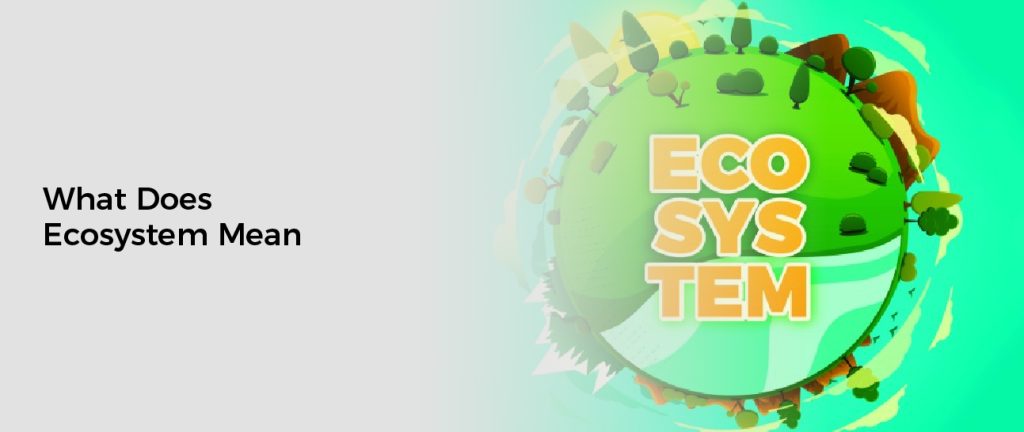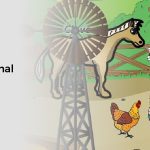Do you ever take a pause to appreciate the world around you? Whether it be your backyard, pond, or even an entire forest – the environment that encompasses these places is now commonly known as ‘the ecosystem.’ But what does ecosystem mean, and why is understanding this concept so important? Dive into this blog post and discover how essential ecosystems are for our well-being. Learn about the different components of an ecosystem, how each living organism plays its role in nature’s harmony, and develop some insight into everyday practices we can implement that help preserve natural habitats all over the globe.
What is Ecosystem?
An ecosystem is a community of living organisms in conjunction with the nonliving components of their environment, interacting as a system. These biotic and abiotic components are linked through nutrient cycles and energy flow.
Ecosystems provide important services to humans, such as water purification and oxygen production, among many others. They also provide habitats for species that are essential to our food chains and agricultural systems. All of these services make ecosystems invaluable to our society and economy.
Importance of Ecosystem
Ecosystems are important for many reasons, but one of the most significant is that they provide various services to humans. These services include water purification, nutrient cycling, and oxygen production. They also provide habitats for species that are essential to our food chains and agricultural systems.
Additionally, they can help to regulate climate and provide flood protection. Finally, ecosystems also support recreational activities like fishing, hunting, and bird watching.
Structure of Ecosystems
Ecosystems can be divided into two basic components: biotic (living) and abiotic (non-living).
- Biotic components include things such as plants, animals, fungi, bacteria, and microorganisms.
- Abiotic components include the physical environment, such as air, soil, water, temperature, and sunlight.
Types Of Ecosystems
There are five main types of ecosystems: freshwater, marine, desert, forest, and grassland. Each one contains different organisms that are adapted to the environment.
- Freshwater ecosystems are found in lakes, ponds, rivers, and streams.
- Marine ecosystems consist of coastal areas such as estuaries and coral reefs.
- Desert ecosystems can be found in arid regions with sandy soils and sparse vegetation.
- Forest ecosystems are composed of trees and other woody plants, while grassland ecosystems include savannas and prairies.
These ecosystems provide habitat for animals and plants that rely on the resources available in each environment. Moreover, they all play an important role in the global carbon cycle, helping to regulate the climate.
Keystone Species Survival Within Their Ecosystems
The term keystone species refers to plants and animals that act as critical to the survival of other species within their ecosystem. They are the “top stone” of an ecosystem, influencing the distribution of prey and nutrient vectors, as well as the system’s overall structure.
Keystone species can be found in any habitat. These include trees, insects, and animals. Depending on the habitat, keystone species have different roles in the food web.
For example, in the ocean, the ivory tree coral, a marine keystone, serves as a critical food source for thousands of invertebrate species. It is also a vital shelter for fish and other organisms.
In a forest, the fig tree provides food for many birds, including bats. Figs also bear fruit year-round and provide nutrients for insect larvae.
The Heterotrophic Segment Of The Ecosystem
The heterotrophic segment of an ecosystem is the level at which plants and other organisms depend on autotrophs for food. Heterotrophs are also known as consumers. These organisms are usually found in the second and third levels of the food chain.
Heterotrophs are categorized according to the energy processes they use to create food. They include photoheterotrophs, chemoheterotrophs, and autotrophs. Other than that, photosynthesis is the process where sunlight is used to convert carbon dioxide into glucose. This glucose is then released into the atmosphere as oxygen. Phytoplankton is also a major source of food for heterotrophs.
An important role of decomposers is recycling waste materials from the various trophic levels. Some examples of decomposers are fungi, worms, and insects. These organisms use fecal waste, plant material, and animal remnants to produce energy and nutrients.
How Human Activities Effects Ecosystem
Human activities can have a major impact on the natural world. The effects range from direct to secondary. The common impacts are pollution, overpopulation, overfishing, and habitat loss.
Pollution is the release of harmful substances into the environment. Typical sources of air pollution are industrialized and animal agriculture, including burning fossil fuels. Sulfur dioxide is released into the air when coal is burned.
The increase in global temperatures is also a big factor. This affects various ecosystems, including oceans and wetlands. Many species are threatened by extinction.
Deforestation, or removing natural land covers, is a major threat to biodiversity. Deforestation changes the ecosystem dramatically. It disrupts the cycle of evaporation and condensation, releasing large amounts of CO2. In addition, it releases greenhouse gases.
Impacts Of Climate Change on Ecosystems
The impacts of climate change on ecosystems have the potential to alter their structure and function drastically. In turn, it may disrupt the relationships between species. Human activities, such as land use change, pollution, and habitat destruction, exacerbate these changes.
Although many species have shown resilience to changes in climate in the past, a number are facing increased risks of extinction. Some species have already been displaced from their traditional ranges. Others change their physical and phenotypic traits as they respond to warmer temperatures.
Adaptation strategies can be difficult to implement. In addition, they must be flexible and coordinated across landscape scales. This may be particularly difficult in the case of the United States, where local topography is a key factor.
For example, the distribution of deciduous forests in the eastern United States may shift, with many relocating to the high elevations of mountainous regions. A reduction in precipitation in the growing season can affect these forests more than grasslands, which are more tolerant to reduced precipitation.
Conclusion
Ecosystems are essential for human life on earth as they provide various services that are invaluable to society and the economy. They are composed of biotic and abiotic components that interact to create a complex system. Ecosystems are important because they provide us with essential services such as water purification, nutrient cycling, oxygen production, and climate regulation. Many of these services would be lost without healthy ecosystems, making life on Earth much more difficult.


